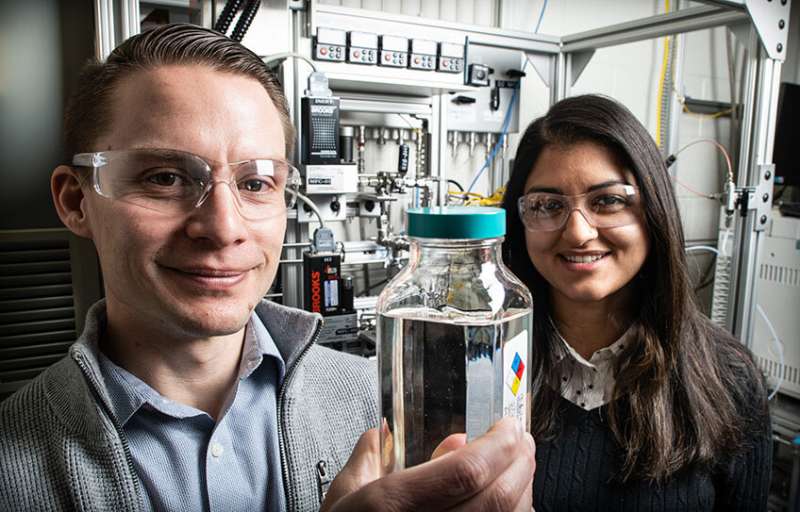Research yields potential bioblendstock for diesel fuel

The NREL scientists, along with colleagues at Yale University, Argonne National Laboratory, and Oak Ridge National Laboratory, are part of the Department of Energy's Co-Optimization of Fuels & Engines (Co-Optima) initiative. Co-Optima's research focuses on improving fuel economy and vehicle performance while also reducing emissions.
"If you look at biomass, 30% of it is oxygen," said Derek Vardon, a senior research engineer at NREL and corresponding author of a new paper detailing the Co-Optima research project. "If we can figure out clever ways to keep it around and tailor how it's incorporated in the fuel, you can get a lot more out of biomass and improve the performance of diesel fuel." The molecule, 4-butoxyheptane, contains oxygen while conventional petroleum-derived diesel fuel is comprised of hydrocarbons. The presence of oxygen significantly reduces the intrinsic sooting tendency of the fuel upon burning.
The paper, "Performance-advantaged ether diesel bioblendstock production by a priori design," appears in the journal Proceedings of the National Academy of Sciences. Vardon's co-authors from NREL are Nabila Huq as the first author, with co-authors Xiangchen Huo, Glenn Hafenstine, Stephen Tifft, Jim Stunkel, Earl Christensen, Gina Fioroni, Lisa Fouts, Robert McCormick, Matthew Wiatrowski, Mary Biddy, Teresa Alleman, Peter St. John, and Seonah Kim.
Researchers used corn stover-derived molecules as the starting point for an array of potential fuel candidates. From here, they relied on predictive models to determine which molecules would be best to blend with and improve traditional diesel. The molecules were prescreened based on attributes with implications spanning health and safety to performance.
"With the goal of developing drop-in biofuels that work with our existing infrastructure," Vardon said, "there are a lot of rules and regulations out there that a fuel has to meet. That eliminates a lot of promising molecules because they may be great in certain properties but fail in others. As we're doing this process, it started to become clear which molecules could be successful fuels."
The intention is to blend the 4-butoxyheptane molecule into diesel fuel at a mixture of 20%-30%. Initial results suggest the potential to improve ignition quality, reduce sooting, and improve fuel economy of the base diesel at these blend levels.
Further research is needed, Huq said, including testing the bioblendstock in an actual engine and producing the fuel in an integrated process directly from biomass.
"That first step was just seeing what could rise to the top as far as fuel properties go," she said. "Then it was asking, can we make any of these? The molecule that looked most promising was 4-butoxyheptane, and we were able to successfully produce and characterize it." The molecule didn't exactly match the predicted fuel properties but came close enough to meet the desired performance improvements.
An economic and life-cycle analysis revealed the oxygenate fuel could be cost-competitive with petroleum diesel and result in significant greenhouse gas reductions if the process also yields a high-value co-product such as adipic acid, which is used in the manufacture of nylon.
More information: Nabila A. Huq et al, Performance-advantaged ether diesel bioblendstock production by a priori design, Proceedings of the National Academy of Sciences (2019). DOI: 10.1073/pnas.1911107116
Journal information: Proceedings of the National Academy of Sciences
Provided by National Renewable Energy Laboratory




















